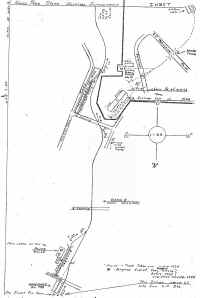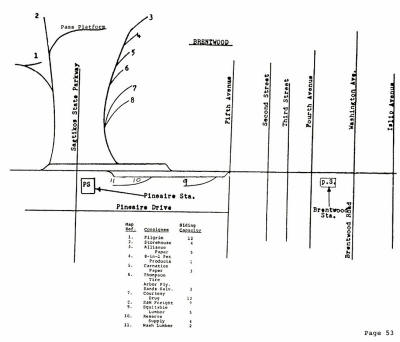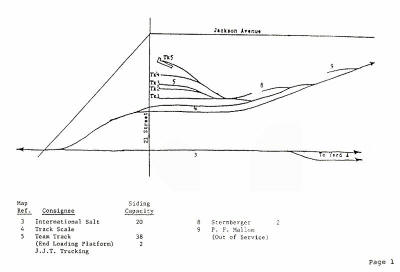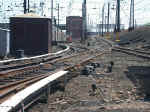|
General
Definitions
Drill tracks connect with the
ladder track, over which locomotives and cars move back and forth in
switching.
 Manure tracks were located all over Long Island from the 1920s and earlier. Believe it not, LI was a great producer of manure. so . . if you think LI has gone to $hit now . . . consider what it did back then to warrant sidings for the transport of the merchandise! Kings Park Hospital once had a manure track as part of the
spur as seen on this Emery 1957 map as abandoned. Manure tracks were located all over Long Island from the 1920s and earlier. Believe it not, LI was a great producer of manure. so . . if you think LI has gone to $hit now . . . consider what it did back then to warrant sidings for the transport of the merchandise! Kings Park Hospital once had a manure track as part of the
spur as seen on this Emery 1957 map as abandoned.
"Back" Track - Located north of
Main line #1 Brentwood locations 3-8

Contractor's Siding on the above
map next to the passenger platform. From: Dave Keller archives
Scale tracks were a general term for tracks that had a scale to weigh consignments like coal or potatoes. (LI
City and Patchogue)

LI City map 1986 - Track Scale location #4
Team tracks were a general term for tracks that customers shipped and/or received their LCL freight consignments.
Cripple tracks for car(s) in need of repair labeled "bad order".
Connect tracks connect one major
facility to another.  Q Tower and Harold Sunnyside
Q Tower and Harold Sunnyside
Ashpit tracks were tracks with pits below the rails into which the used contents of the locomotive's fireboxes were dumped.
Garden tracks were a general term for the tracks radiating out from a turntable.
Storage tracks are self-explanatory.
Pocket tracks usually a siding
to place a few cars temporarily; to spot them and remove them quickly.
Inspection tracks were tracks that had pits constructed between the rails and upon which locomotives were inspected.
Coaling tracks were tracks upon which locomotives were coaled.
Sand tracks/sidings were tracks upon which locomotives took on sand or
sand was loaded into hoppers/gondolas for transport; Whitepot, in the
19th Century, for example
Boneyard tracks were a general term for the scrap line.
RIP tracks: RIP (Repair In
Place) tracks.
Dock tracks are tracks that extended out on a dock, i.e. Greenport, old Montauk, old Oyster Bay, Sag Harbor, etc.
Hump tracks were tracks in marshalling yards that were raised and over which a car was released to coast down the respective storage track when making up consists. They were at first ridden down by a brakeman at the brake wheel and later, electric retarders were installed to brake the cars. Cars with fragile merchandise bore the sign
"Do Not Hump" - a favorite to all railroad men with dirty minds!
Dave Keller
Lead tracks led somewhere. The
main track accessing a turntable was a lead track.
Ladder tracks are a series of
turnouts providing access to any of several parallel yard tracks.
Ready tracks have locomotives
available for service. (PRR Sunnyside Yard)
 Sunnyside Service Area c. 1980 Photo: Bob Redden
Sunnyside Service Area c. 1980 Photo: Bob Redden
This photo shows: Wash Tracks, Ash Pits, Engine Repair, and Ready
Tracks
Wash tracks have facilities to clean passenger/locomotive
units . West Islip
West Islip
“Shoo-fly”
track used as a temporary track; usually to route trains around
ongoing construction, wreck, or natural disaster; i.e. washout, rock
slide, etc. (See Rockville Centre below)
|